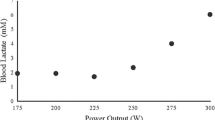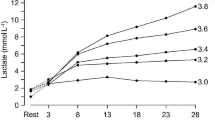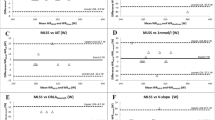Abstract
The aim of this study was to estimate the characteristic exercise intensity\(\dot W\) CL which produces the maximal steady state of blood lactate concentration (MLSS) from submaximal intensities of 20 min carried out on the same day and separated by 40 min. Ten fit male adults [maximal oxygen uptake\(\dot V{\text{O}}_{\text{2}} \) max 62 (SD 7) ml · min−1 · kg−1] exercisOed for two 30-min periods on a cycle ergometer at 67% (test 1.1) and 82% of\(\dot V{\text{O}}_{\text{2}} \) max (test 1.2) separated by 40 min. They exercised 4 days later for 30 min at 82% of\(\dot V{\text{O}}_{\text{2}} \) max without prior exercise (test 2). Blood lactate was collected for determination of lactic acid concentration every 5 min and heart rate and O2 uptake\(\dot V{\text{O}}_{\text{2}} \) were measured every 30 s. There were no significant differences at the 5th, 10th, 15th, 20th, 25th, or 30th min between\(\dot V{\text{O}}_{\text{2}} \), lactacidaemia, and heart rate during tests 1.2 and 2. Moreover, we compared the exercise intensities\(\dot W\) CL which produced the MLSS obtained during tests 1.1 and 1.2 or during tests 1.1 and 2 calculated from differential values of lactic acid blood concentration ([1a−]b) between the 30th and the 5th min or between the 20th and the 5th min. There was no significant difference between the different values of\(\dot W\) CL [68 (SD 9), 71 (SD 7), 73 (SD 6),71 (SD 11) % of\(\dot V{\text{O}}_{\text{2}} \) max (ANOVA test,P<0.05). Four subjects ran for 60 min at their\(\dot W\) CL determined from periods performed on the same day (test 1.1 and 1.2) and the difference between the [la−]b at 5 min and at 20 min (Δ ([la−]b)) was computed. The [la−]b remained constant during exercise and ranged from 2.2 to 6.7 mmol · l−1 [mean value equal to 3.9 (SD 1) mmol · l−1]. These data suggest that the\(\dot W\) CL protocol did not overestimate the exercise intensity corresponding to the maximal fractional utilization of\(\dot V{\text{O}}_{\text{2}} \) max at MLSS. For half of the subjects the\(\dot W\) CL was very close to the higher stage (82% of\(\dot V{\text{O}}_{\text{2}} \) max where an accumulation of lactate in the blood with time was observed. It can be hypothesized that\(\dot W\) CL was very close to the real MLSS considering the level of accuracy of [la−]b measurement. This study showed that exercise at only two intensities, performed at 65% and 80% of\(\dot V{\text{O}}_{\text{2}} \) max and separated by 40 min of complete rest, can be used to determine the intensity yielding a steady state of [la−1]b near the real MLSS workload value.
Similar content being viewed by others
References
Aitken JC, Thompson J (1988) The effects of previous severe exercise upon respiratory exchange ratio as a predictor of maximum oxygen uptake. Eur J Appl Physiol 57:720–725
Chwalbinska-Moneta, Hänninen O (1989) Effect of active warming-up on thermoregulatory, circulatory, and metabolic responses to incremental exercise in endurance-trained athletes. Int J Sports Med 10:25–29
De Bruyn-Prevost P (1980) The effects of various warming-up intensities and durations upon some physiological variables during an exercise corresponding to the WC170. Eur J Appl Physiol 43:93–100
De Bruyn-Prevost P, Lefebvre F (1980) The effects of various warming-up intensities and durations during a short maximal anaerobic exercise. Eur J Appl Physiol 43:101–107
Di Prampero P (1986) The anaerobic threshold concept a critical evaluation. Adv Cardiol 35:24–34
Gutin B, Wilkerson JE, Horvath SM, Rochelle RD (1981) Physiological response to endurance work as a function of prior exercise. Int J Sports Med 2:87–91
Heck H, Mader A, Hess G, Mücke S, Müller R, Hollmann W (1985) Justification of the 4 mmol/l lactate threshold. Int J Sports Med 6:117–130
Houmard JA, Johns RA, Smith LL, Wells JM, Kobe RW, McGoogan SA (1991) The effect of warm-up on responses to intense exercise. Int J Sports Med 12:480–483
Ingjer F, Stromme SB (1979) Effects of active, passive or no warm-up on the physiological response to heavy exercise. Eur J Appl Physiol 40:273–282
Kindermann W, Simon G, Keul J (1979) The significance of aerobic-anaerobic transition for the determination of workload intensities during endurance training. Eur J Appl Physiol 42:25–34
Knowlton RG, Miles DS, Sawka MN (1978) Metabolic responses of untrained individuals to warm-up. Eur J Appl Physiol 40:1–5
Lafontaine TP, Londeree BR, Spath WK (1981) The maximal steady-state versus selected running events. Med Sci Sports Exerc 13:190–192
Londeree BR, Ames SA (1975) Maximal lactate steady-state versus states of conditioning. Eur J Appl Physiol 34:1–10
Martin BJ, Robinson S, Wiiegman DL, Aulick LH (1975) Effect of warm-up on metabolic responses to strenuous exercise. Med Sci Sports Exerc 7:146–149
Mognoni P, Sirtori MD, Lorenzelli F, Ceretelli P (1990) Physiological responses during prolonged exercise at the power output corresponding to the blood lactate threshold. Eur J Appl Physiol 60:239–243
Nagle F, Robinhold D, Howley E, Daniels J, Baptista G, Stoedefalke K (1970) Lactic acid accumulation during running at submaximal aerobic demands. Med Sci Sports Exerc 2:182–186
Noll F (1974) Methoden der enzymatischen Analyse. Bergmeyer HV (ed). Verlag Chemie, Weinheim
Oyono-Enguelle S, Heitz A, Marbach J, Ott C, Gartner M, Pape A, Vollmer JC, Freund H (1990) Blood lactate during constant-load exercise at aerobic and anaerobic thresholds. Eur J Appl Physiol 60:321–330
Pendergast D, Cerretelli P, Rennie DW (1979) Aerobic and glycolytic metabolism in arm exercise. J Appl Physiol Respir Environ Exerc Physiol 47:754–760
Rieu M, Miladi J, Ferry A, Duvallet A (1989) Blood lactate during submaximal exercises comparison between intermittent incremental exercises and isolated exercises. Eur J Appl Physiol 59:73–79
Rieu M, Ferry A, Martin MC, Duvallet A (1990) Effect of previous supramaximal work on lacticaemia during supra-anaerobic threshold exercise. Eur J Appl Physiol 61:223–229
Robergs RA, Costill DL, Fink WJ, Pascoe DD, Chwalbinska-Moneta J, Davis JA (1990) Effects or warm-up on blood gases, lactate and acid-base status during sprint swimming. Int J Sports Med 11:273–278
Sargeant AJ, Dolan P (1987) Effect of prior exercise on maximal short-term power output in humans. J Appl Physiol 62:1475–1480
Schnabel A, Kindermann W, Schmitt WM, Biro G, Stegmann H (1982) Hormonal and metabolic consequences of prolonged running at the individual anaerobic threshold and the fixed anaerobic threshold of 4 mmol · l−1 lactate. Int J Sports Med 3:163–168
Sjödin B, Jacobs I (1981) Onset of blood lactate accumulation and marathon running performance. Int J Sports Med 2:23–26
Stamford BA, Rowland R, Moffatt RJ (1978) Effects of severe prior exercise on assessment of maximal oxygen uptake. J Appl Physiol Respir Environ Exerc Physiol 44:559–563
Stegmann H, Kindermann W (1982) Comparison of prolonged exercise tests at individual anaerobic threshold and the fixed anaerobic threshold of 4 mmol · l−1 lactate. Int J Sports Med 3:105–110
Taylor HL, Buskirk E, Henschel A (1955) Maximal oxygen intake as an objective measure of cardiorespiratory performance. J Appl Physiol 8:73–80
Urhausen A, Coen B, Weiler B, Kindermann W (1993) Individual anaerobic threshold and maximum lactate steady-state. Int J Sports Med 14:134–139
Yoshida T (1984) Effect of exercise duration during incremental exercise on the determination of anaerobic threshold and the onset of blood lactate accumulation. Eur J Appl Physiol 53:196–199
Author information
Authors and Affiliations
Rights and permissions
About this article
Cite this article
Billat, V., Dalmay, F., Antonini, M.T. et al. A method for determining the maximal steady state of blood lactate concentration from two levels of submaximal exercise. Europ. J. Appl. Physiol. 69, 196–202 (1994). https://doi.org/10.1007/BF01094788
Accepted:
Issue Date:
DOI: https://doi.org/10.1007/BF01094788




